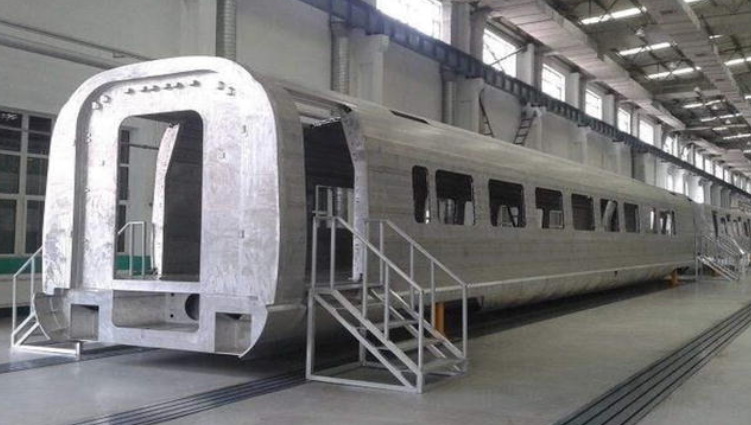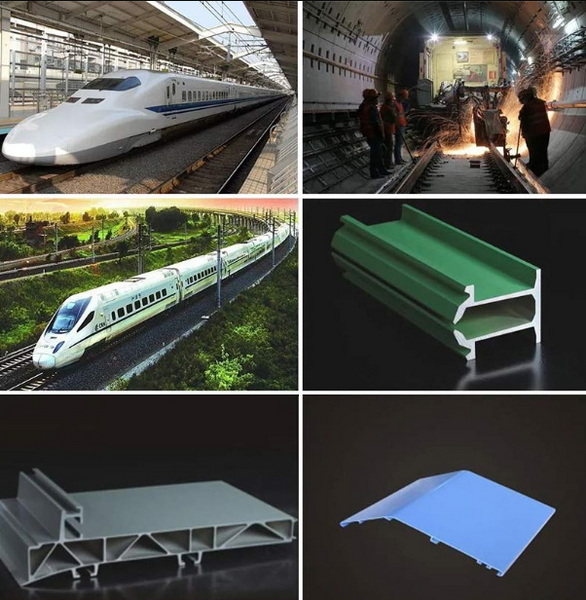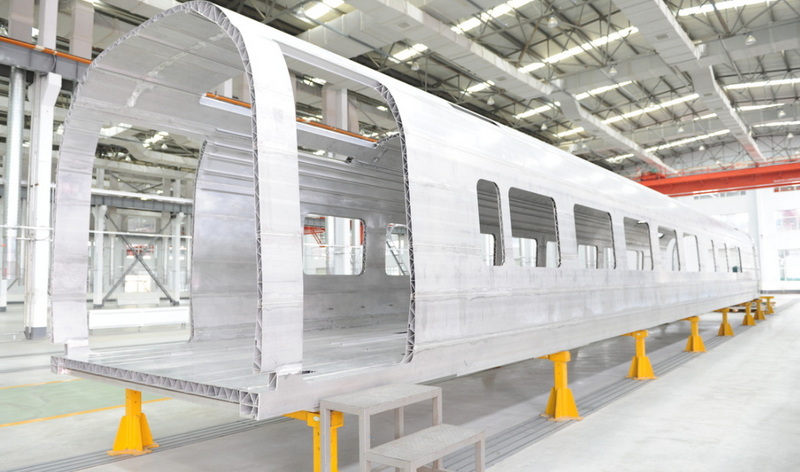Content Menu
● The Importance of Aluminum in High-Speed Rail
● Key Components of an Aluminum Extrusion Machine
● The Aluminum Extrusion Process: A Step-by-Step Guide
● Types of Aluminum Extrusion
● Innovations in Aluminum Extrusion Technology
● Applications Beyond Bullet Rails
● The Future of Aluminum Extrusion
● Specific Alloys for Bullet Train Rails
● Quality Control and Testing
● Sustainability in Aluminum Extrusion
● Surface Finishing and Treatments
● The Role of Extrusion in High-Speed Rail Development
● Conclusion
● FAQ
>> 1. What are the main advantages of using aluminum in bullet trains?
>> 2. How does direct extrusion differ from indirect extrusion?
>> 3. What is quenching, and why is it important in the aluminum extrusion process?
>> 4. What are some common surface treatments applied to aluminum extrusions?
>> 5. How is sustainability addressed in the aluminum extrusion industry?
● Citations:
Aluminum extrusion is a versatile manufacturing process used to create a wide array of products with specific cross-sectional profiles. Among its many applications, it plays a crucial role in the production of components for high-speed rail systems. An "aluminum bullet rail extruder" is a specialized machine designed to produce the aluminum components used in the construction of modern bullet trains. These components demand high precision, strength, and reliability to ensure the safety and efficiency of high-speed rail travel.

The Importance of Aluminum in High-Speed Rail
Aluminum is an ideal material for high-speed trains due to its unique combination of properties[4]:
- Lightweight: Reducing the weight of train components is crucial for achieving higher speeds and lower energy consumption[4].
- High Strength-to-Weight Ratio: Aluminum provides the necessary structural integrity without adding excessive weight[4].
- Corrosion Resistance: Aluminum's natural resistance to corrosion ensures a long service life, even in harsh environmental conditions[1].
- Extrudability: Aluminum can be easily extruded into complex shapes, allowing for optimized designs[1].
Key Components of an Aluminum Extrusion Machine
An aluminum extrusion machine typically consists of three main parts:
- Extrusion Head: This includes the die, heater, pretreatment device, and extrusion cavity. The die shapes the aluminum, while the heater ensures it is soft enough to be formed[7].
- Hydraulic System: This system provides the high pressure needed to push the aluminum through the die. It includes a fuel tank, oil pump, and high-pressure cylinders[3][12].
- Control System: This system controls the operation of the entire machine, using a PLC controller, human-machine interface, and electrical components to automate the process[2].
The Aluminum Extrusion Process: A Step-by-Step Guide
The aluminum extrusion process involves several key steps[12]:
1. Die Preparation: The die, which determines the shape of the final product, is preheated to between 450-500°C to maximize its life and ensure even metal flow[7].
2. Billet Preparation: Aluminum billets, typically cylindrical, are cut to the required length and preheated to a temperature range of 400-500°C[5]. This preheating softens the aluminum, making it malleable enough to be shaped without compromising its structural integrity[5].
3. Billet Transfer: The preheated billet is then transferred to the extrusion press, where a lubricant is applied to prevent the billet and ram from adhering to each other[12].
4. Extrusion: The hydraulic ram of the extrusion press applies immense pressure, up to 15,000 tons, to force the billet through the die[5][11][12]. The aluminum expands to fill the container walls before being pressed against the die[12].
5. Quenching: As the aluminum is forced through the die, it emerges in the desired shape. The newly formed extrusion is then quenched, rapidly cooled using air or water[3][13]. Quenching sets the crystal structure of the metal, giving the extrusion its desired mechanical properties[3][13].
6. Stretching: After cooling, the extruded profiles are stretched to correct any twisting or bending that may have occurred during the extrusion and quenching processes[7][11]. This ensures the final product is straight and meets the required dimensional tolerances[7].
7. Cutting: The stretched extrusions are then cut to the specified lengths[11].
8. Aging: Finally, the cut lengths are artificially aged in ovens at around 190°C for 4-8 hours to achieve the desired strength and hardness[11].
Types of Aluminum Extrusion
There are two primary methods of aluminum extrusion: direct and indirect[5].
- Direct Extrusion: In direct extrusion, the ram pushes the heated aluminum billet through a stationary die[5]. This is the most common method[5].
- Indirect Extrusion: In indirect extrusion, the die moves while the billet remains stationary[5]. This method reduces friction and allows for better temperature control[5].
Here's a table summarizing the key differences:
| Aspect | Direct Extrusion | Indirect Extrusion |
| Billet Movement | Billet moves through a stationary die | Billet remains stationary while the die moves |
| Friction | Higher | Lower |
| Temperature Control | Less precise | More precise |
| Common Use Cases | Structural components, frames | Applications needing smoother finishes and precision |
Innovations in Aluminum Extrusion Technology
Several advancements have enhanced the aluminum extrusion process[2][10]:
- 3D Printing: 3D printing is used to create complex die molds, improving speed and accuracy compared to traditional methods[2].
- Automation: The use of robotics and automated systems increases efficiency, reduces costs, and improves quality[2].
- CAD Technology: Computer-aided design (CAD) technology enables the creation of aluminum profiles with complex contours and improves accuracy[2].
- Alloy Innovation: New aluminum alloys offer improved strength, corrosion resistance, and weldability[10].
- Flexible Dies: Flexible tooling adapts extrusion dies "on the fly" for small batch production runs and rapid prototyping[10].
- Simulation: Advanced simulation software models material flow, temperature, and stress to test the viability of extrusion processes virtually[10].

Applications Beyond Bullet Rails
While *aluminum bullet rail extruders* are specifically designed for high-speed rail components, aluminum extrusion, in general, has a wide range of applications across various industries[1][5][9]:
- Transportation: Aluminum extrusions are used in engine blocks, transmission housings, and vehicle frames[1][9].
- Automotive: Aluminum is ideal for making lightweight yet durable parts, improving fuel efficiency by reducing overall vehicle weight[5].
- Aerospace: Aluminum extrusions are crucial in aircraft frames and structural components due to their high strength-to-weight ratio[5].
- Construction: Aluminum extrusions are used in window frames, door systems, and building facades due to their durability and weather resistance[1][5][9].
- Electronics: Aluminum extrusions are used in heat sinks and protective cases for electronic components[5].
The Future of Aluminum Extrusion
The future of aluminum extrusion looks promising, with ongoing innovations and increasing demand across various industries[10]. The development of new alloys, advanced automation techniques, and sustainable practices will further enhance the efficiency and versatility of the process[10]. As industries continue to seek lightweight, strong, and corrosion-resistant materials, aluminum extrusion will remain a vital manufacturing process[1][5][9].
Specific Alloys for Bullet Train Rails
The specific aluminum alloys used in bullet train rails are designed to meet stringent performance requirements[8]. These alloys typically contain additions of zinc, magnesium, manganese, and zirconium to enhance strength, fatigue resistance, and corrosion resistance[8]. For example, an aluminum alloy material might consist of 93% Al, 4% Zn, 1.5% Mg, 0.4% Si, 0.36% Fe, 0.2% Mn, 0.06% Cr, 0.08% Zr, 0.2% Ti, and 0.2% Cu[8]. The exact composition is often proprietary and tailored to specific performance needs[8].
Quality Control and Testing
Quality control is paramount in the manufacturing of aluminum components for bullet trains[4][8]. The extrusions undergo rigorous testing to ensure they meet the required standards for strength, dimensional accuracy, and surface finish[4][8]. Non-destructive testing methods, such as ultrasonic testing and X-ray inspection, are used to detect any internal flaws or defects[8].
Sustainability in Aluminum Extrusion
The aluminum industry is increasingly focused on sustainability[6]. Recycling aluminum requires only 5% of the energy needed to produce primary aluminum, making it a highly sustainable material[6][9]. Modern extrusion facilities are implementing energy-efficient technologies and waste reduction strategies to minimize their environmental impact[6].
Surface Finishing and Treatments
Aluminum extrusions often undergo surface finishing and treatments to enhance their appearance, corrosion resistance, and wear resistance[5][9]. Common surface treatments include anodizing, powder coating, and painting[5][9]. Anodizing creates a protective layer of aluminum oxide on the surface, improving corrosion resistance and providing a decorative finish[5][9]. Powder coating involves applying a colored powder to the surface, followed by curing in an oven to create a durable and attractive finish[5][9].
The Role of Extrusion in High-Speed Rail Development
The development of high-speed rail networks around the world relies heavily on advanced materials and manufacturing processes[4]. Aluminum extrusion plays a critical role in enabling the construction of lightweight, strong, and durable train components[4]. As high-speed rail technology continues to advance, so too will the aluminum extrusion processes used to create these essential components[4].
Conclusion
In conclusion, an *aluminum bullet rail extruder* is a sophisticated machine that utilizes the principles of aluminum extrusion to produce vital components for high-speed trains. The process involves careful control of temperature, pressure, and material composition to ensure the final product meets stringent performance requirements. With ongoing innovations in extrusion technology and a growing emphasis on sustainability, aluminum extrusion will continue to play a crucial role in the advancement of high-speed rail and other industries.

FAQ
1. What are the main advantages of using aluminum in bullet trains?
Aluminum offers a unique combination of properties, including being lightweight, having a high strength-to-weight ratio, excellent corrosion resistance, and ease of extrusion, making it ideal for high-speed train construction[4].
2. How does direct extrusion differ from indirect extrusion?
In direct extrusion, the ram pushes the aluminum billet through a stationary die, while in indirect extrusion, the die moves while the billet remains stationary[5]. Direct extrusion is more common, but indirect extrusion offers better temperature control and reduced friction[5].
3. What is quenching, and why is it important in the aluminum extrusion process?
Quenching is the rapid cooling of the extruded aluminum profile immediately after it exits the die[3][13]. It is important because it sets the crystal structure of the metal, giving the extrusion its desired mechanical properties and preventing deformation[3][13].
4. What are some common surface treatments applied to aluminum extrusions?
Common surface treatments include anodizing, powder coating, and painting[5][9]. These treatments enhance the appearance, corrosion resistance, and wear resistance of the aluminum extrusions[5][9].
5. How is sustainability addressed in the aluminum extrusion industry?
The aluminum industry is increasingly focused on sustainability by promoting recycling, implementing energy-efficient technologies, and reducing waste[6][9]. Recycling aluminum requires only a fraction of the energy needed to produce primary aluminum[6][9].
Citations:
[1] https://kimsen.vn/uses-of-aluminum-extrusion-ne37.html
[2] https://www.retop-industry.com/news/29.html
[3] https://www.youtube.com/watch?v=P8BWQBP4Vhk
[4] https://www.lightmetalage.com/news/industry-news/extrusion/extrusions-used-construction-chinas-new-electric-bullet-train/
[5] https://hitopindustrial.com/aluminum-extrusion-process/
[6] https://taberextrusions.com/how-taber-does-that-aluminum-extrusion-innovation-and-technology/
[7] https://kdmfab.com/aluminum-extrusion/
[8] https://patents.google.com/patent/CN106555088A/en
[9] https://www.hydro.com/profiles/uses-of-aluminum-extrusions
[10] https://www.findtop.com/the-history-and-future-of-aluminum-extrusion/
[11] https://hydal.se/wp-content/uploads/2019/10/Hydal_ExtrusionDesignManual_2019_EN-complete_low_rev-1.pdf
[12] https://www.rapiddirect.com/blog/aluminum-extrusion-process/
[13] https://hackaday.com/2020/08/13/under-pressure-how-aluminum-extrusions-are-made/
[14] https://hydal.se/wp-content/uploads/2019/10/Hydal_ExtrusionDesignManual_2019_EN-complete_low_rev-1.pdf
[15] https://www.step-g.com/applications/rail-vehicles
[16] https://www.canray.com.tr/en/technology/
[17] https://hackaday.com/2020/08/13/under-pressure-how-aluminum-extrusions-are-made/
[18] https://www.alumforge.com/product/aluminum-bullet-rail-extrusions/
[19] https://journals.sagepub.com/doi/10.1177/16878132231222791?icid=int.sj-abstract.citing-articles.6
[20] https://www.daboosanat.com/wp-content/uploads/2018/02/0012-Extrusion-of-Aluminium-Alloys.pdf
[21] https://www.wileymetal.com/five-common-applications-of-aluminum-extrusion/
[22] https://bondtechnologies.net/rail-car-manufacturing-high-speed-rail-systems-get-a-boost-with-bonds-gantry-machines/
[23] https://aluminium.org.au/wp-content/uploads/2023/01/Aluminium-Extrusion-Manual-Feb23.pdf
[24] https://aec.org/industries
[25] https://extrusion-dies.ru/assets/files/Aluminum_Extrusion_Technology_P_Saha.pdf
[26] https://www.kobelco.co.jp/english/releases/2014/1190507_13891.html
[27] https://extruderpress.com/aluminum-extrusion-press/
[28] https://extal.com/en/the-evolution-of-aluminum-extrusion-techniques-with-extal/
[29] https://www.gabrian.com/what-is-aluminum-extrusion-process/
[30] https://www.impol.com/everything-you-need-to-know-about-aluminum-extrusion/
[31] https://eagle-aluminum.com/the-aluminum-extrusion-process/
[32] https://taberextrusions.com/aluminum-powers-new-high-speed-rail-technology/
[33] https://shop.machinemfg.com/the-aluminum-manufacturing-process-a-comprehensive-guide/
[34] https://www.ryerson.com/metal-resources/metal-market-intelligence/5-questions-on-aluminum-extrusions
[35] https://aec.org/faqs
[36] https://kdmfab.com/tr/aluminum-extrusion/
[37] https://www.alumforge.com/xh/product/aluminum-bullet-rail-extrusions/
[38] https://www.rightonblackburns.co.uk/news/guide-to-the-aluminium-extrusion-process
[39] https://profileprecisionextrusions.com/5-initial-questions-ask-aluminum-extruder/
[40] https://xingji-alu.en.made-in-china.com/product/gmdUcFLYgEkV/China-No-1-Good-Quality-Aluminium-Extrusion-Profile-for-Transport-Conductor-Guide-Rail-Assembled-to-High-Speed-Railway.html
[41] https://zjaluminum-cnc.com/the-ultimate-guide-for-aluminum-extrusion/
[42] https://journals.sagepub.com/doi/abs/10.1177/16878132231222791
[43] https://www.easiahome.com/aluminum-extrusion-metal-extrusion-process/
[44] https://ai.motion.com/what-t-slot-aluminum-extrusion-do-i-use/
[45] https://leadrp.net/blog/a-complete-guide-to-aluminum-extrusion/
[46] https://dajcor.com/learning-centre/faq
[47] https://www.lightmetalage.com/news/industry-news/extrusion/extrusions-used-construction-chinas-new-electric-bullet-train/
[48] https://hitopindustrial.com/aluminum-extrusion-process/
[49] https://www.minalex.com/2021/10/29/10-questions-ask-aluminum-extruder/
[50] https://patents.google.com/patent/CN106555088A/en






















